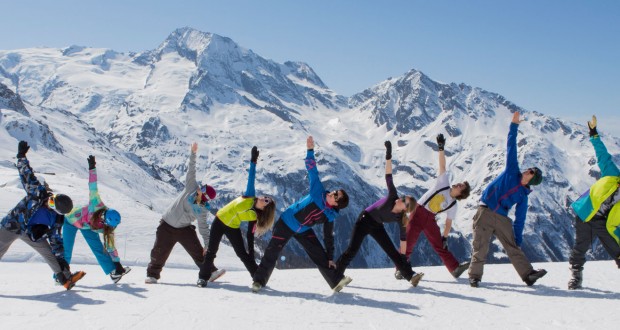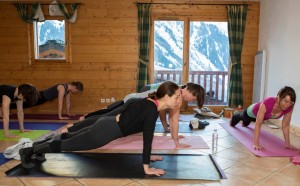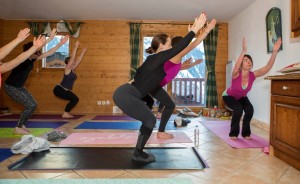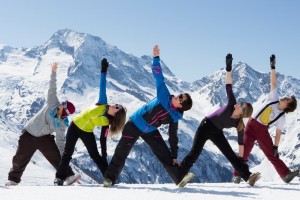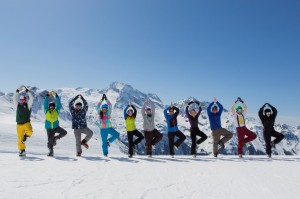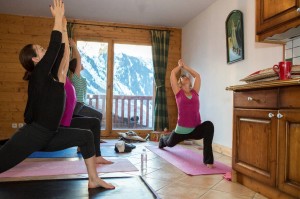Yoga-ski is the new trend, says Juliet Francis.
Like any physical sport, skiing can trigger pain and soreness if you haven’t built strength to navigate Alpine slopes. So says Mr Rajiv Bajekal, consultant orthopaedic surgeon at Highgate Private Hospital:
“If you spend summer indoors and exercise is a distant memory and suddenly go skiing for a full day, then your legs will hurt the next day. Instead, you can start a pre-ski conditioning programme at least six weeks before you ski to get your muscles ready. Put the focus on strength training for your legs and interval training on a stationary bicycle at high resistance for muscular endurance. Yoga is a great way to build resistance and increase flexibility, so if you can, combine daily yoga poses whilst skiing. Find a yoga class near you, or alternatively start yoga classes online to get your body ready for yoga so that you can focus on how the skiing is affecting your body when you are on your holiday, rather than the yoga contributing to muscles aches.”
How often should we practice yoga before going away?
If you already practice yoga: I would recommend starting about 3 weeks before, if you have an intermittent yoga practice, and if all you can squeeze in is 20 minutes in the morning and 1 yoga class a week this is good enough to tune in those muscle groups so when the skiing starts they won’t be shocked at the strain put on them.
If you are a beginner: 6 weeks before. Classes can come in 6 weeks blocks so sign up to a course and don’t miss any! Also try some at home using the poses recommended below which are ski specific. Here are some recommended poses that target specific muscles groups related to skiing. The combination of these will help improve your overall ability in skiing or snowboarding.
1. The core – Plank Pose
Benefits: Engaging the core muscles of the abdomen also enhances good turns on the slopes and alleviates pressure from the knees, protecting the joint from injury. Strengthening the core muscles helps to improve balance that is essential for skiing and also helps redirect weight bearing that often falls onto the knees. Awareness of your centre allows you to initiate movement, helps you turn more efficiently and distribute weight more evenly making each move less strenuous on the whole body. Hold it for as long as you can and count to 10 and then come down. Do this 5 times. (See inset picture right)
2. For the legs and strength – Chair Pose (Utkatasana)
Benefits: The is a Classic ski and board posture, it warms up and builds strength in quads. You can also try this by standing at a wall and leaning your back against it and bending the knees as if you are sitting on a chair and seeing how long you can stay there for. Do this for 1 minute, focusing on the correct position of chest, back and pelvis. (See inset picture left)
3. To stretch the legs (and side body) – Triangle Pose
Benefits: This pose is a great all over body toner, it stretches the inner thighs, the hamstrings and IT band and also the side body which is great for upper body movement and agility when making turns in the snow. The key here is to tuck the bum in and engage the core and keep your back straight and shoulders back. (See inset picture right)
4. For balance – Tree Pose (Vrksasana)
Benefits: This helps with balance, tones and strengthens quads, calves, ankles and spine whilst stretching hip flexors, inner thighs, chest and shoulders. Improves balance and promotes mobility in the hip and knee joint, which is important when making turns. The key here is to fix your gaze on something to help maintain balance and at the same time inhale and keeping palms together lift the arms above the head. Lower the shoulders and relax them. Hold, breathing deeply and through the stomach. Repeat on the other side. (See inset picture left)
5. Hip flexors – Forward Kneeling Lunge (Anjaneyasana)
Benefits: This posture is great for stretching out the hip flexors, which shorten in a sedentary lifestyle. By lengthening them you help with overall hip movement which will help aid flexibility and agility and improves posture and lower back stability and improves calf flexibility. The key here is to keep hips lunging forward. Draw left thigh downward, stretching left groin & quadriceps. Breathe and hold for 40-60 seconds. Not moving right foot inhale and come to standing. Do the same on the opposite side. (See inset pictured right)
Adventureyogi has planned ski and yoga retreats in the French Alps in January and throughout March.
www.adventureyogi.com
 Good Ski Guide The Worlds Most Loved Ski Guide
Good Ski Guide The Worlds Most Loved Ski Guide
